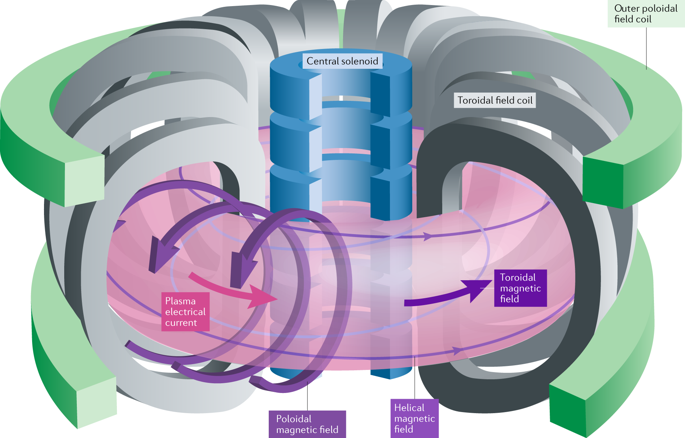Nature Reviews Physics ( IF 44.8 ) Pub Date : 2020-02-14 , DOI: 10.1038/s42254-019-0144-1 Christopher Ham , Andrew Kirk , Stanislas Pamela , Howard Wilson

|
The tokamak is the most advanced approach to fusion and is approaching operation under power-plant conditions, promising sustainable, low-emission, baseload power to the grid. As the heating power of a tokamak is increased above a threshold, the plasma suddenly bifurcates to a state of high confinement, creating a region of plasma with a large pressure gradient at its edge. This bifurcation results in a repetitive sequence of explosive filamentary plasma eruptions called edge-localized modes (ELMs). ELMs on next-step tokamaks, such as ITER, will likely cause excessive erosion to plasma-facing components and must be controlled. We present what is understood about how ELMs form, their filamentary nature and the mechanisms that transport heat and particles to the first wall of the tokamak. We also discuss methods to control ELMs, including magnetic perturbations.
中文翻译:

丝状等离子体爆发及其对聚变能量路径的控制
托卡马克是最先进的融合方法,正在发电厂条件下运行,有望向电网提供可持续的,低排放的基本负荷电力。当托卡马克的加热功率增加到阈值以上时,等离子体突然分叉成高约束状态,从而在其边缘创建具有大压力梯度的等离子体区域。这种分叉导致重复的爆炸性丝状血浆喷发序列,称为边缘定位模式(ELM)。下一步托卡马克(如ITER)上的ELM可能会严重腐蚀面向等离子体的组件,因此必须加以控制。我们介绍了关于ELM的形成方式,其丝状性质以及将热量和颗粒传输到托卡马克第一壁的机理的理解。我们还将讨论控制ELM的方法,











































 京公网安备 11010802027423号
京公网安备 11010802027423号